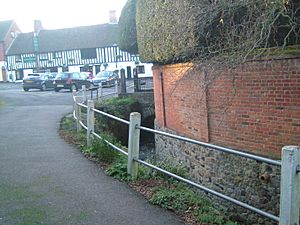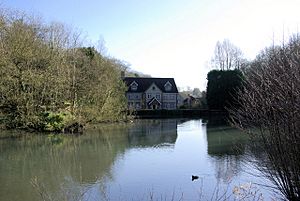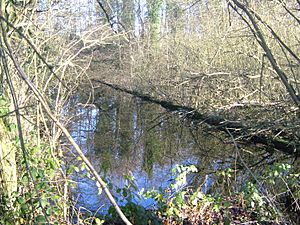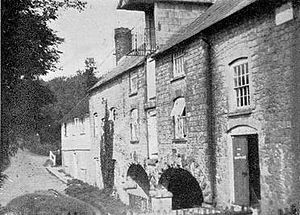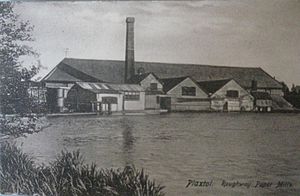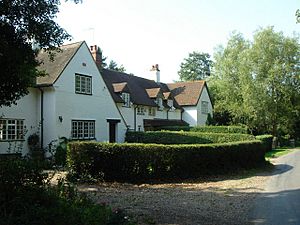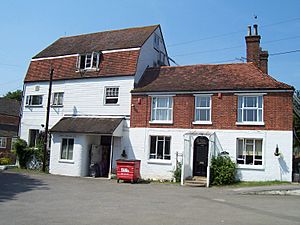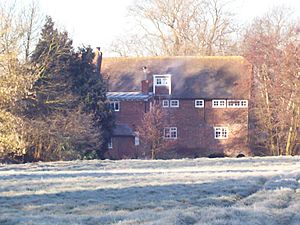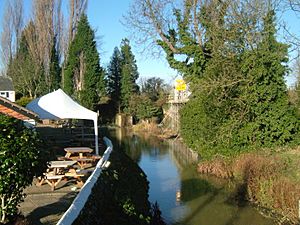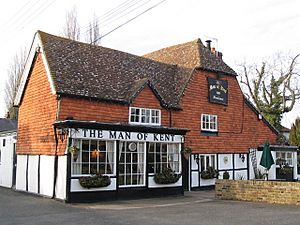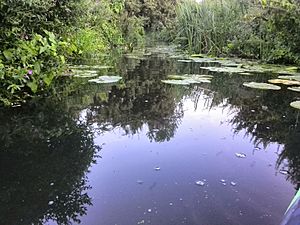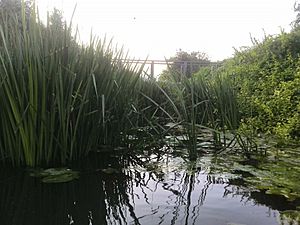River Bourne, Kent facts for kids
Quick facts for kids River Bourne |
|
|---|---|
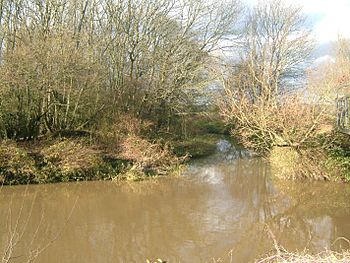
The River Bourne enters the Medway
|
|
| Physical characteristics | |
| Main source | Ightham. TQ 597 567 249 feet (76 m) 51°17′13″N 0°17′28″E / 51.2869°N 0.2911°E |
| River mouth | River Medway, East Peckham. TQ 664 477 42 feet (13 m) 51°12′15″N 0°22′59″E / 51.2042°N 0.3830°E |
| Length | 10-mile (16 km) |
The River Bourne is a river in Kent, England. It starts in the village of Ightham and flows southeast. The river passes through several towns like Borough Green, Platt, Plaxtol, West Peckham, Hadlow, and East Peckham. Finally, it joins the River Medway.
Hundreds of years ago, in the 1700s, people called this river by other names. It was known as the Busty or Buster, and sometimes the Shode or Sheet. Today, these old names are not used. The word bourne means a small stream. The word shode means a branch of a river.
Contents
- River Bourne's Journey and Features
- Watermills Along the River Bourne
- Old Mill, Borough Green
- Basted Paper Mill, Platt
- Lower Basted (Johns) Mill, Plaxtol
- Winfield Mill, Plaxtol
- Longmill, Plaxtol
- Roughway Paper Mill, Plaxtol
- Hamptons Paper Mill, West Peckham
- Oxonhoath Mill, West Peckham
- Bourne (Hope, Lambert's) Mill, Hadlow
- Goldhill (Bourneside, Victoria) Mill, Golden Green
- Pierce Mill, Golden Green
- Little Mill, East Peckham
- River Branches and Mills
- Wildlife in the River Bourne
- Boating on the River Bourne
- Walking Paths Along the River
River Bourne's Journey and Features
The River Bourne gets its water from several springs. There are a few ideas about where the river truly begins. One idea is a spring on the North Downs at New House Farm. Another is a spring near Oldbury Hill, which the Environment Agency prefers. A third idea is a spring on Oldbury Hill itself. This spring feeds a pond called the Waterflash.
All these smaller streams come together in Ightham. Here, the Bourne has carved a deep channel, about 117 feet (36 m) deep, through the rock. In 1891, scientists found ancient remains from the ice age in a quarry nearby. The river then flows through forests to Basted. Here, a mill pond shows that the river was once used for industry.
From Ightham to Golden Green, the river's power was used by many watermills. You can still see names of roads that remind us of these mills. These mills mostly made flour and paper. The area near East Peckham often floods. The River Bourne adds a lot of water, so it is watched and cleaned regularly. This helps the water flow smoothly and prevents flooding. There is a special station at Hadlow that measures the river's water levels.
Watermills Along the River Bourne
The River Bourne was very important for powering many watermills. These mills used the river's flow to turn large wheels. There were 12 main mills along its 10-mile (16 km) length. Let's look at some of them, starting from the river's beginning.
Old Mill, Borough Green
This mill was in Borough Green. We don't know much about it. Its millpond was about 75 yards (68.58 m) long and 25 feet (7.62 m) wide. The water dropped about 6 feet (1.83 m) to power the mill.
Basted Paper Mill, Platt
This mill made paper. It was working as early as 1716. The millpond here was much larger, about 175 yards (160.02 m) long. The mill burned down in 1917. It was rebuilt and used steam power until 1960. The mill finally closed after being damaged by floods in 1968. This mill even supplied paper for postage stamps! Although often linked to Borough Green, the mill was actually in Platt.
Lower Basted (Johns) Mill, Plaxtol
This mill was just a short distance downstream from Basted Paper Mill. An old map from 1825 shows it as John's Mill. Not much else is known about this mill.
Winfield Mill, Plaxtol
Winfield Mill was a corn mill. It was built in 1836 using ragstone, a type of local rock. Millers like James Full worked here. The mill was still standing in 1940 but was a ruin by 1950. It had a large waterwheel that was 11 feet (3.35 m) across and 12 feet (3.66 m) wide. This wheel was built in 1874. Some parts of the millstones can still be seen today. An even older mill was on this site in 1699.
Longmill, Plaxtol
This was a corn mill that has been lost over time. Today, only Longmill Lane reminds us of its existence.
Roughway Paper Mill, Plaxtol
This mill was built around 1807. It used both steam and water power. It made paper that was used for printing postage stamps for other countries. A tall chimney at the mill was a well-known landmark. It was taken down in 1997 after a fire.
Hamptons Paper Mill, West Peckham
This paper mill was built in 1740. It was used until the 1880s. When it was built, it was 75 feet (22.86 m) long and 24 feet (7.32 m) wide. Only small parts of the foundations remain today. It was likely powered by a waterwheel inside the building. The mill was taken down around 1890. However, the old mill cottages still stand across the road.
Oxonhoath Mill, West Peckham
People have lived at this mill site since 1259. It was used as a fulling mill (for cleaning cloth) and later as a corn mill. The mill building was still there in 1930, but its machinery had been removed. Today, only parts of the lower walls remain.
Bourne (Hope, Lambert's) Mill, Hadlow
This mill might be mentioned in the Domesday Book, a famous survey from 1086. The mill building is still standing. It had a large waterwheel on the outside. The mill was used until 1947. After that, a clothing factory started there, which is still in business today. The mill was also known as Hope Mill.
Goldhill (Bourneside, Victoria) Mill, Golden Green
Golden Green is a small village in Hadlow. This mill might also date back to the Domesday Book. It is special because it is the only mill on the Bourne that still has most of its original machinery. The waterwheel is made of iron and is 14 feet (4.27 m) across. The mill had two sets of millstones and last ground corn around 1920. In the early 1900s, the mill was used to make electricity. The buildings around the mill have now been turned into holiday homes.
Pierce Mill, Golden Green
We don't know much about this mill. Pierce Mill Lane is named after it. The mill was named after the Pierce family, who were millers there.
Little Mill, East Peckham
This mill building is still standing. Part of it has been turned into a house, and part has been taken down. It had a waterwheel that pushed water from the front.
River Branches and Mills
The River Bourne has smaller streams, called tributaries, that flow into it.
- One tributary starts in Hildenborough and flows through Shipbourne. It used to power a mill called Uridge's Mill and a pump at Claygate. This stream then joins the Bourne.
- A smaller stream, branching off the first tributary, powered a sawmill at Fairlawne Home Farm.
- Another tributary joins the Bourne at Basted Paper Mills. It might have powered a mill in Crouch.
Uridge's Mill, Shipbourne
This mill was named after Robert Uridge, a miller who worked there for 16 years. We don't know its exact location.
Claygate pump, Shipbourne
This was a waterwheel that powered a pump. Its exact location is also unknown.
Fairlawne Saw Mill, Plaxtol
This sawmill was on an estate and was powered by a waterwheel.
Crouch Mill, Platt
There might have been a mill at Salmons Farm in Crouch. An old map from 1845 mentions a "hop garden adjoining mill," which suggests a mill was there.
Wildlife in the River Bourne
The River Bourne is home to different kinds of fish and other creatures.
- You can see Chubb fish in the river near Little Mill.
- Crayfish can be found in the river at Ightham.
- Brown trout fish can be seen near Goldhill Mill in Golden Green.
Boating on the River Bourne
In the summer of 2014, people could canoe on the Bourne from the River Medway. You could go about 200 meters until plants blocked the way. This was before the "Man of Kent" pub in East Peckham. In winter 2012, it was reported that you could go all the way to the pub, but the last 100 yards were rocky.
Long ago, it might have been possible to carry goods on the river to the main road in East Peckham. An old map from 1891 shows a large tannery (a place that makes leather) using the Bourne's water near Little Mill. The river by the tannery even had a special cut-out for boats to dock.
Walking Paths Along the River
Several walking paths cross or follow the River Bourne.
- The Greensand Way, a long-distance path, crosses the river at Dunk's Green.
- The Wealdway, another long-distance path, crosses at Barnes Street.
- The Medway Valley Walk marks where the Bourne flows into the Medway at Waggon Bridge, East Peckham.
- Hadlow Parish Council has even created a special walk that follows the Bourne from Ightham all the way to the Medway.
Old historical paths also cross the river. The ancient Pilgrims' Way passes through Yaldham. A Roman army road from Maidstone to London crosses the Bourne at Ightham.



